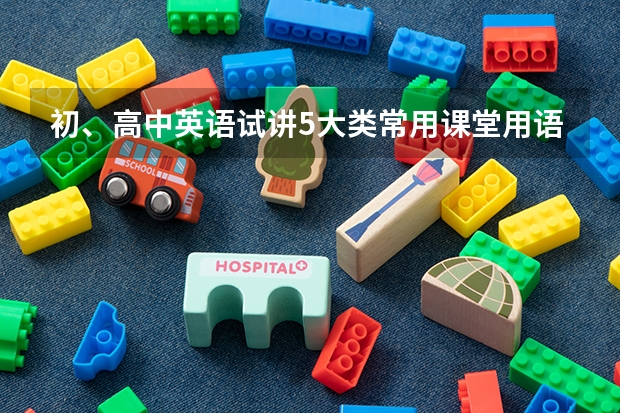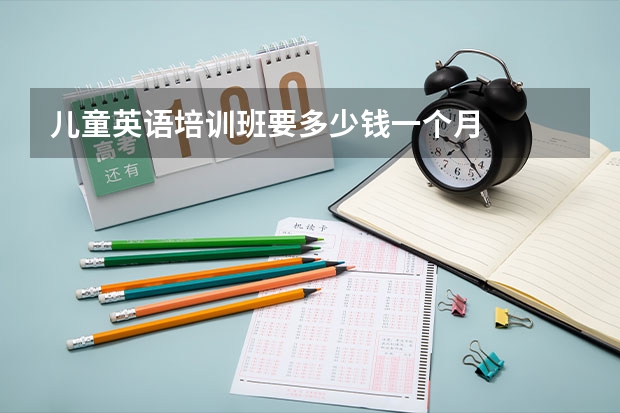初、高中英语试讲5大类常用课堂用语(英语课常用的课堂用语)
2023-12-02 21:37:33 | 金大话英语培训网
本文目录一览:

初、高中英语试讲5大类常用课堂用语
中学英语教师资格证试讲常用课堂用语一、打招呼(Greetings)、导入环节
老师学会主动与学生打招呼,是老师了解学生的方式之一。也是拉近师生关系的基本交流方式。这样的交流方式,容易增添学生对老师的好感,让学生愿意敞开心扉和老师交流。A good beginning makes a good ending. 一个好的开端能够为老师教学奠定良好的基础。
参考用语:
Good morning/afternoon, class./boys and girls.
It's so nice/I'm so happy to see you again.
Good , you look great/ wonderful today.
How's it going?
How are you (today)?
You look so happy, any good news?
It’s time for class.
OK, class/ boys and girls , are you ready to have class/begin?
Let’s begin/begin our lesson.
Stand up, please!
Are you all well this morning? Well, did you have a good weekend? Did you enjoy the holiday? Well, what did you do yesterday evening? Tell me what you did at the weekend?
二、指示 /课堂教学(Direction/Teaching)
在组织课堂教学时,教师使用的指示语和演示语要避免过长和含糊不清,要力求简洁、清晰并且和蔼、可亲,避免过于生硬。例如:
Now class/ boys and class, class begins.
Today, we're going to learn …
Now, open your books, please. Turn to page ...
Now, class/ boys and girls/ children, please look at the blackboard/picture/your books/ page five.
Please read the … together. One, two, three, go!
Now, let's sing the song… together.
Now, let's enjoy the song from the tape.
Well, let's go on. Please look at page …
This time, you do it one by one.
Now, listen to the tape.
Now, listen to me, please.
Now, I'll read the …, please follow me.
Now class/ boys and girls/ children , read after me/ the tape.
Follow me, please.
Just follow me, class .
Yes, please. (To answer “ Let me try or let me answer the question ”)
Please show me how well you can do/ read it.
Speak louder, please.
Once again, but louder, please.
Again, Slowly.
One more time.
Come to the front, please. / … please come to the front . Thank you.
Thank you. Please go back to your seat.
Thank you. You can go back now.
It's your turn, Sue.
OK, class/ boys and girls/ children , please stand up.
Please sit down.
Please do it now.
OK, go!
Please work in pairs/ in groups/ individually/ by yourselves.
Now, class/ boys and girls/ children, write/put the Chinese/English under/next to each word/picture.
Now, let's do the exercise.
Now, class/ boys and girls/ children, find a partner and role-play the conversation.
Work with your partner and answer the questions.
OK, class/ boys and girls/ children, time is up. Please stop working/ talking now.
Please stop here.
Now, break time.
Let's have/ take a break.
Good class/ boys and girls/ children, be quite, please.
Now class/ boys and girls/ children, here's your homework. Please do … and …
Don't forget your homework. It's … on page …, …on page…
Just listen, Don't repeat.
Listen with your books closed.
Listen carefully and do what I say.
Listen to my question first.
Say it with me.
How do you spell "flower"?
Look at the picture and tell me what you
see.
What do you call this in English?
What does ... mean?
What's the opposite of "happy"?
Read it silently.
Let's do a role play.
Who wants to be Mr. Green?
Do you want to be Mary or Mark?
Let's read the text aloud.
Write it on the blackboard.
Copy the new words.
Take out a piece of paper, please.
Take out your book(s).
One card for each group.
Can you share with Jack, please?
You may look at your book this time.
Has everybody got a copy?
Can you find the right page?
Do you know where we are?
Turn back to page 21.
Do you understand?
Do you know what to do?
Any questions/ problems?
Is everything clear?
Are there any questions?
三、组织课堂活动(Organizing classroom activities)
Now, let's play a game.
Today, we are going to play a new game.
This time, we're going to do a guessing/
counting/ spelling game.
Let's act out our play!
Let's sing a song.
First, let's just listen to the tune.
Sing along with the tape.
Do it yourself.
Work on your own.
Find a friend / partner.
Work (together) with your friend/ partner.
Work in pairs.
Do it in pairs.
You two work together.
Henry, turn around and work with Mary.
Has everybody got a partner?
Get together in groups.
Work in groups.
Work in groups of four.
Let's do some group work.
Let's make two teams.
Now, I'm going to divide you into three groups.
Let's start/ begin!
One, two, three, go!
Ready? Go!
You have two minutes.
Finish it in one minute.
One more minute.
Let's do it all together.
Whose turn is it?
Let's move to the next one.
Who hasn't got a chance?
Finished?
Let's stop here.
It's time to stop.
Time's up.
Any volunteers?
Anyone else?
Does anyone know the answer?
Could somebody tell me the answer?
Who'd like to try first?
Who wants to be the teacher?
Who can tell me the answer?
Who wants to go first?
Could you come to the front?
四、反馈语(The feedback language)
反馈语是课堂教学活动的重要组成部分,是教师评价和评估学生课堂表现的重要手段,也是推动教学活动进展的有效方法。对学生英语学习的评价现在提倡多种方式和多元化。这其中反馈语是教师对学生课堂表现的一种评价方式。教师要注意树立评价意识。不仅要对学生课堂上的学习表现给予评价,对学生情感、态度的表现都应通过评价给予鼓励,达到激励学生的目的。
在使用语言行为评价时教师要注意语气和目光的注视,使学生对老师的表扬和肯定感到真切。
反馈语可分为肯定式评语、参与式评语和启发式纠错。
(1)肯定式评语
教师在使用肯定式评语对学生的课堂表现进行肯定和表扬时,一定要让学生感到老师是在由衷地夸奖他。要避免敷衍和流于形式。不要滥用‘Good’。有的老师过多地单一使用 ‘Good’ 评价学生的表现,很难使学生从中受到激励,激发学习的积极性。
参考用语:
Not bad. Thank you. (I'm sure you can do better next time.)
Good!Thank you. (I could see you've practiced a lot.)
Good boy/ girl . That's a good answer. Thank you.
Quite good! (I really appreciate your effort.)
Very good!(I really enjoy it.)
Great! (You did a good job.)
Excellent! (Let's give him/her a big hand!)
Wonderful!(I'm so proud of you.)
Well done! (Good boy/girl.)
Your answer is very good! (I admire your work.)
Nice going! (You make a great progress.)
对学生有创意的、创新的思维火花及灵感,发言中的闪光点的肯定,可以使用以下的用语:
What a bright idea! Thank you.
That's a great answer. (I really like it.)
You did a good job! (We're so proud of you!)
Good point! (I really enjoy it.)
Good job! (I'm very pleased with your work.)
Smart! (What an adorable baby!)
Perfect! (You're very professional.)
You are such a smart boy/girl!
You got sharp eyes/ears.
I couldn't believe my ears!
Brilliant!
Terrific!
Excellent!
Amazing!
Fantastic!
Marvelous!
You've done it much better this time.
You've made a lot of progress.
You've progressed a lot.
You've improved a lot.
I hope you will do better next time.
Take it easy.
Don't worry, It doesn't matter.
Don't be shy.
Don't be afraid of making mistakes.
That's OK, No one is perfect.
Take a guess if you don't know.
You can do it.
Come on! Have a try.
Take your time, Try it one more time.
(2)参与式评语
在采用学生之间互相评价的手段时,教师要注意不要拿学生跟别人比,要拿学生同他自己比。教师可以说:同学们说某某同学说得好不好呀?进步大不大呀?
在让学生参加评价时可以使用疑问和反意疑问句:
Is it good?
Isn't it a good answer?
Do you like his/her answer/reading?
Did he/she do a good job?
That's a fantastic answer, isn't it?
He/she did an excellent job, didn't he/she?
(3) 启发式纠错
当学生犯错误时,教师要避免使用否定的评价语言,要给他们可能获得成功的机会,鼓励他们,保护他们的学习积极性。
如:
That's very close. Go on!
It's almost right. Try again, please.
Come on! Think it over. I'm sure you can do it.
I'm sure you can do it if you really try. (See? You did it really well.)
Sorry, I'm sure you can do it better next time.
I'm sorry. Would you like a second try? /Would you like to try again?
Not bad. Go on, please.
Come on, It's very close.
It doesn't matter. I'm sure you can do it better next time.
(4)非语言评价及策略
非语言评价—既运用手势,表情(眼神、面容、微笑)及其他肢体动作语言(body language) 来对学生的学习进行的评价。在使用语言行为评价方式的同时注意非语言评价方式的使用可以加强评价效果。
方式和策略:
① 微笑加语言。
② 用力点头---是一种肯定。
③ 惊讶的表情 + 可表示赞赏。
④ 竖起大拇指,可表示一种高度的赞赏。增强自信心,获得成就感。
⑤鼓掌---当学生任务完成得出色时,教师可鼓掌表示赞扬。也可以号召学生一起鼓掌。掌声可以使人产生成就感,增强自信心。
五、课堂结束语(Saying goodbye)
课堂教学结束时教师需向学生宣布,并向学生道别。
OK, class/ boys and girls, that's all for today. I'll see you next time.
Let's call it a day today. I'll see you the day after tomorrow.
Alright class/ boys and girls/ children. We'll stop here today.
We'll end up the class now.
Class is over.
Have a good weekend!
Have a nice day/ weekend/ vacation!
Wish you a good weekend.

英语课常用的课堂用语
英语课常用的课堂用语:
pardon 原谅:这个单词翻译直译是原谅等意思,如果学生在课堂上没听清楚,不妨说一句:pardon,相当于“请再说一遍”的意思。
again 虽然也是“再次”的意思,但不宜对着老师直接使用,而是要跟一个 please单词,“again please”,这样比较礼貌。
Can you say that again please?你能再说一遍吗?这是一句比较完整的求助于老师的句子。
You’re great。We should clap for you。棒极了,我们应该为你鼓掌。
Don’t give up。Try your best。别放弃,尽你的全力。
I admire you for your works。我十分佩服你说的话。 金大话英语培训网
Don’t be afraid。Show your confidence。别害怕,拿出你的勇气。
Don’t lose heart。You can try it again。别灰心,你可再试一次。
Whose turn is it to clean the blackboard? 轮到谁擦黑板了?
Can you see the blackboard clearly? If not, come up to the front。你们能看清黑板吗?如果不能,向前来一点。
Class begins。Now please open your books and turn to Page 43。Let’s go over what we learned last lesson。Well, look at the dialogue, and let’s practise it once again, shall we? 首先,让我们复习一下我们上节所学内容,好,看这个对话,让我们再练习一遍。
Have finished the exercises which I gave you last time? How about revising them again, OK? 在复习一遍,好吗?
How about another practise on this point?All right? 对于这一要点,我们在复习一遍,好吗?
Now this is about what we learned last lesson。Are you clear? 这是我们上节课所学内容,清楚了吗?
I’ll check your homework。Answer these questions according to the last lesson。根据上节内容回答我的问题。
Listen to the dialogue once more and complete these exercises。再听一遍并完成这些练习。

【英语课堂组织教学的技巧】英语课堂组织用语
课堂组织教学是指教师通过协调课堂内的各种教学因素而有效地实现预定的教学目标的过程。课堂组织教学是一项融科学和艺术于一体的富有创造性的工作。要做好这项工作,教师不仅要懂得课堂教学规律,掌握一定的教育学、心理学知识,还必须关注每一位学生,运用一定的组织艺术,努力调动学生的有意注意,激发学生的情感,使学生在愉快、轻松的心境中全身心地投入到学习中去。我通过几年的英语教学实践,总结出了如下一些课堂组织教学的技巧。
一、声音控制法:声音控制法指教师通过语调、音量、节奏和速度的变化,来引起和控制学生的注意。例如,当教师从一种讲话速度变到另一种速度时,已分散的注意力会重新集中起来。在讲解中适当加大音量,也可以起到加强注意和突出重点的作用。
二、表情控制法:丰富的表情变化也可以起到控制学生注意力的作用。教师的表情表达对学生的暗示、警告和提示,也可以表达期待、鼓励、探询、疑惑等情感。教师面部表情、头部动作、手势及身体的移动也传递着丰富的信息,有助于沟通师生间的交流,调控学生的注意力。
三、停顿吸引法:适当的停顿,能够有效地引起学生的注意力,可以产生明显的刺激对比效应。喧闹中突然出现的寂静,可以紧紧抓住学生的注意力。一般来说,停顿的时间以三秒左右为宜。这样的停顿足以引起学生的注意。停顿时间不可过长,长时间停顿反而会导致学生注意力涣散。
四、目光注视法:教师的目光注视可以在学生中引起相关的心理效应,产生或亲近或疏远或尊重或反感的情绪,进而影响教学效果。因此,教学可以巧妙地运用目光注视来组织英语课堂教学。如开始上课时,教师用亲切的目光注视全体同学,使学生情绪安定下来,愉快地投入学习。再如,课上有学生注意力不集中,教师可以用目注视提醒学生注意听讲等。
五、情感暗示法:情感在课堂组织教学中,发挥着动力的作用。如果学生对老师、对课堂缺乏情感,就不能有效地进行学习活动。因此,我们要善于运用各种教学手段,培养和引导学生积极向上的情感,并在成功中产生新的学习动机。
六、姓名举例法:在英语单词或课文教学中,教师常常运用人物名字作主语进行造句或创设情境,以加强学生对所学单词或课文的理解。如果发现有的同学走神、做小动作、低头看其它书籍等,教师可以抓住时机,运用这位学生的名字作主语造句或创设情境。这样既可以顺利完成教学任务,增加英语教学的真实性,又可以起到提醒学生的作用,真可谓妙趣横生、一箭双雕。
七、短暂休息法:连续的操练之后,部分学生可能出现精神疲劳、注意力分散的现象。面对这种情况,教师的提醒或警示对学生注意力的长久保持已无济于事。这时,教师可以播放一段或唱一首英文歌曲,让学生放松片刻。这样,不但消除学生的疲劳,活跃课堂气氛,而且增加师生间的感情。
八、手势示意法:在英语课上,有的学生自控能力差,会交头接耳。面对这种情况,教师可以用双手向他们做出一个暂停的动作或将食指按住嘴唇做出安静的表示,以示意这部分学生保持安静或终止违纪行为。
九、媒体变换法:在课堂教学中,单一的教学媒体容易引起学生疲的记忆、理解和应用,促进由知识向能力的转化。
十、活动变换法:变换课堂活动方法可以有效调动和集中学生的注意力,提高课堂教学效率。课堂活动方式包括师生交流的方式、学生活动的方式和教学评价的方式等。在课堂教学中,教师应根据教学的需要适时变换一下课堂活动方式。例如,由教师讲变为学生讲,由机械操练变为交际操练,由集体听课变为小组讨论,等等。这些变化都会给学生以新鲜的刺激,强化学生的注意,激发其参与的兴趣,进而达到提高教学质量的目的。
十一、设疑吸引法:巧妙的设疑是课堂组织教学中的一种艺术方法。当学生注意力不集中时,教师设计一些疑问,让学生回答,以促进学生注意力的转移。在学生学习情绪低落时,利用疑问引起学生学习的兴趣,激发学生学习的积极性。它在教学中起着承上启下、充实教学内容的作用。但设疑需要教师精心设计,注重提问的思考价值,无目的的设疑会破坏 教学设计 的目标,影响学生思维
十二、竞赛刺激法:在学生学习情绪不佳、疲劳或学习积极性不高时,教师可根据教学内容,开展一些小型教学竞赛活动,如采取集体竞赛、小组竞赛、个人竞赛等,以调动学生的积极性,使学生的有意注意力高度集中,从而使学生跳出不良的学生状态,达到提高教学效果的目的。 以上就是金大话教育网为大家带来的初、高中英语试讲5大类常用课堂用语(英语课常用的课堂用语),希望能帮助到大家!
免责声明:文章内容来自网络,如有侵权请及时联系删除。
-
 青岛最好的培训机构排名 少儿英语培训机构排名 英语培训机构哪家好?
青岛最好的培训机构排名 少儿英语培训机构排名 英语培训机构哪家好?2023-10-30 23:07:22
-
 深圳中考英语辅导班有哪些 排名前十的补习机构
深圳中考英语辅导班有哪些 排名前十的补习机构2023-12-25 00:23:38
-
 雅思课程培训课一般上多久
雅思课程培训课一般上多久2023-11-03 13:47:53
-
 托福培训哪个机构比较好
托福培训哪个机构比较好2024-02-01 03:46:09
-
 儿童英语培训班要多少钱一个月
儿童英语培训班要多少钱一个月2024-01-11 23:40:03
-
 呼市靠谱少儿英语培训课程 呼和浩特市少儿英语教育机构都有哪几家?
呼市靠谱少儿英语培训课程 呼和浩特市少儿英语教育机构都有哪几家?2024-01-07 11:37:58